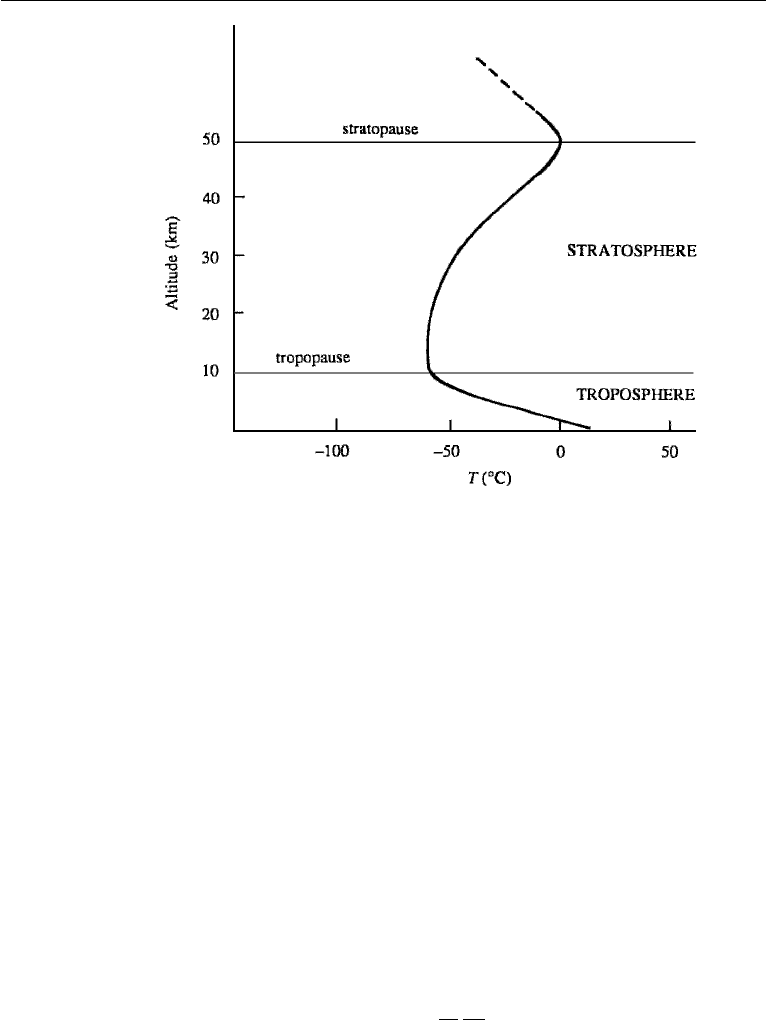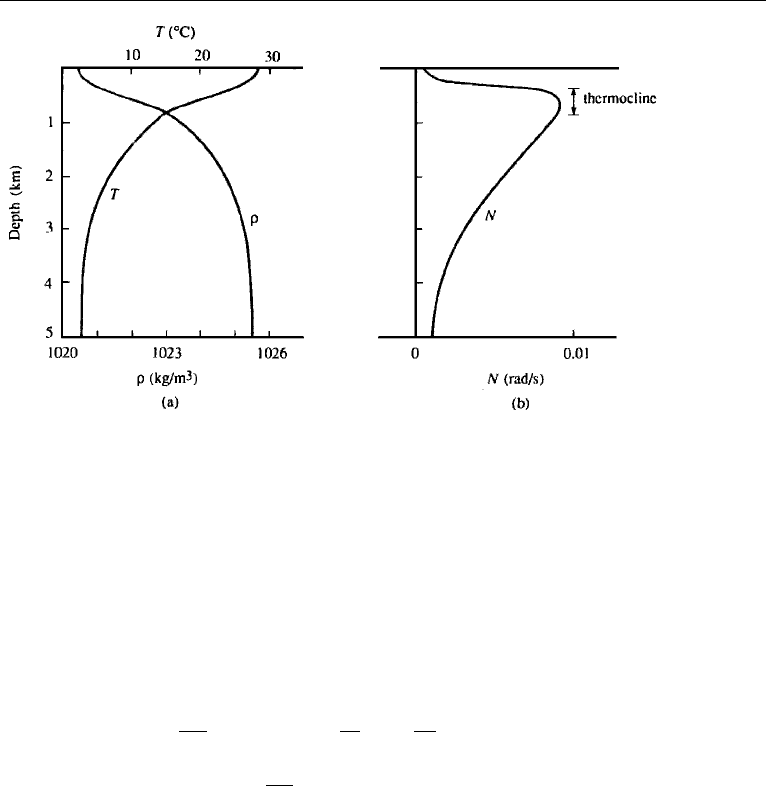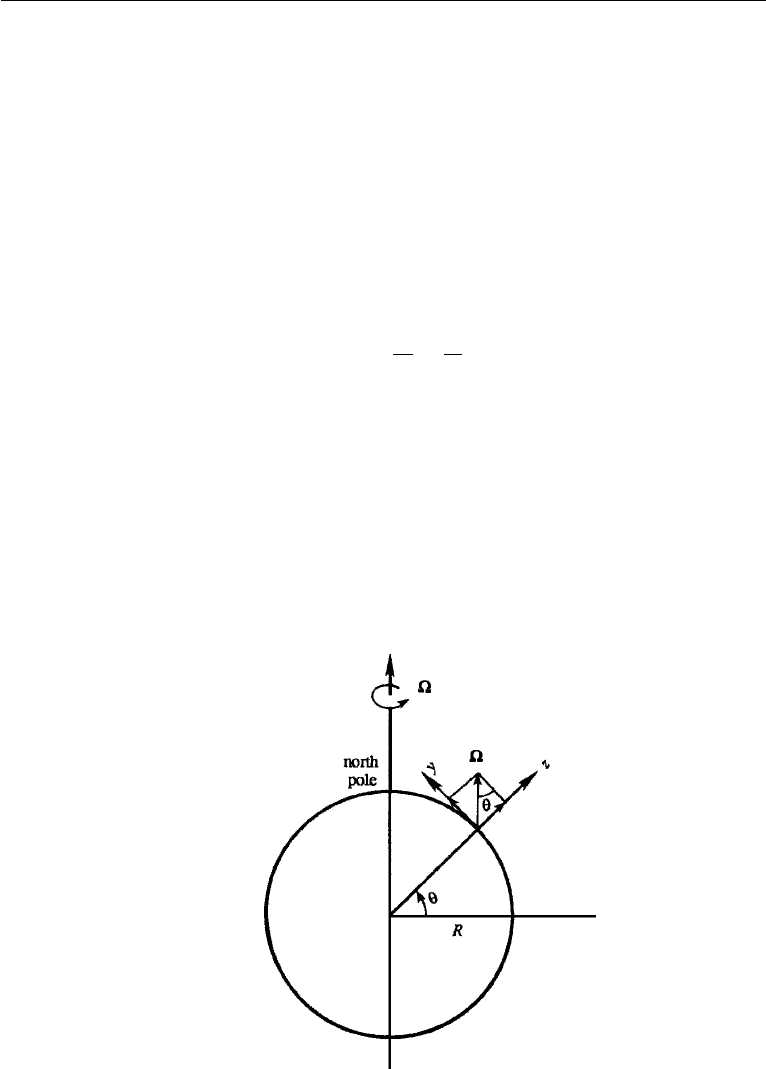Cohen I.M., Kundu P.K. Fluid Mechanics
Подождите немного. Документ загружается.

This page intentionally left blank

Chapter 14
Geophysical Fluid Dynamics
1. Introduction ........................ 603
2. Vertical Variation of Density in
Atmosphere and Ocean .............. 605
3. Equations of Motion ................. 607
Formulation of the Frictional
Term............................. 608
4. Approximate Equations for a Thin
Layer on a Rotating Sphere.......... 610
f -Plane Model ...................... 612
β-Plane Model ...................... 612
5. Geostrophic Flow .................... 613
Thermal Wind....................... 614
Taylor–Proudman Theorem .......... 615
6. Ekman Layer at a Free Surface ...... 617
Explanation in Terms of
Vortex Tilting .................... 622
7. Ekman Layer on a Rigid Surface ..... 622
8. Shallow-Water Equations ............ 625
9. Normal Modes in a Continuously
Stratified Layer ..................... 628
Boundary Conditions on ψ
n
.......... 630
Solution of Vertical Modes for
Uniform N ....................... 631
10. High- and Low-Frequency Regimes in
Shallow-Water Equations ............ 634
11. Gravity Waves with Rotation ......... 636
Particle Orbit ....................... 638
Inertial Motion ...................... 639
12. Kelvin Wave ......................... 639
13. Potential Vorticity Conservation in
Shallow-Water Theory............... 644
14. Internal Waves ...................... 647
WKB Solution ....................... 650
Particle Orbit ....................... 652
Discussion of the Dispersion
Relation. ......................... 654
LeeWave........................... 656
15. Rossby Wave ........................ 657
Quasi-geostrophic Vorticity
Equation. ........................ 658
Dispersion Relation .................. 660
16. Barotropic Instability................ 663
17. Baroclinic Instability ................ 665
Perturbation Vorticity Equation ...... 666
Wave Solution ....................... 668
Boundary Conditions ................ 669
Instability Criterion.................. 669
Energetics........................... 671
18. Geostrophic Turbulence ............. 673
Exercises ............................ 676
Literature Cited ..................... 677
1. Introduction
The subject of geophysical fluid dynamics deals with the dynamics of the atmosphere
and the ocean. It has recently become an important branch of fluid dynamics due to
our increasing interest in the environment. The field has been largely developed by
meteorologists and oceanographers, but non-specialists have also been interested in
the subject. Taylor was not a geophysical fluid dynamicist, but he held the position of
603
©2010 Elsevier Inc. All rights reserved.
DOI: 10.1016/B978-0-12-381399-2.50014-9

604 Geophysical Fluid Dynamics
a meteorologist for some time, and through this involvement he developed a special
interest in the problems of turbulence and instability. Although Prandtl was mainly
interested in the engineering aspects of fluid mechanics, his well-known textbook
(Prandtl, 1952) contains several sections dealing with meteorological aspects of fluid
mechanics. Notwithstanding the pressure for specialization that we all experience
these days, it is worthwhile to learn something of this fascinating field even if one’s
primary interest is in another area of fluid mechanics.
The importance of the study of atmospheric dynamics can hardly be overem-
phasized. We live within the atmosphere and are almost helplessly affected by the
weather and its rather chaotic behavior. The motion of the atmosphere is intimately
connected with that of the ocean, with which it exchanges fluxes of momentum, heat
and moisture, and this makes the dynamics of the ocean as important as that of the
atmosphere. The study of ocean currents is also important in its own right because of
its relevance to navigation, fisheries, and pollution disposal.
The two features that distinguish geophysical fluid dynamics from other areas
of fluid dynamics are the rotation of the earth and the vertical density stratification
of the medium. We shall see that these two effects dominate the dynamics to such an
extent that entirely new classes of phenomena arise, which have no counterpart in the
laboratory scale flows we have studied in the preceding chapters. (For example, we
shall see that the dominant mode of flow in the atmosphere and the ocean is along
the lines of constant pressure, not from high to low pressures.) The motion of the
atmosphere and the ocean is naturally studied in a coordinate frame rotating with
the earth. This gives rise to the Coriolis force, which is discussed in Chapter 4. The
density stratification gives rise to buoyancy force, which is introduced in Chapter 4
(Conservation Laws) and discussed in further detail in Chapter 7 (Gravity Waves). In
addition, important relevant material is discussed in Chapter 5 (Vorticity), Chapter 10
(Boundary Layer), Chapter 12 (Instability), and Chapter 13 (Turbulence). The reader
should be familiar with these before proceeding further with the present chapter.
Because Coriolis forces and stratification effects play dominating roles in both
the atmosphere and the ocean, there is a great deal of similarity between the dynam-
ics of these two media; this makes it possible to study them together. There are also
significant differences, however. For example the effects of lateral boundaries, due to
the presence of continents, are important in the ocean but not in the atmosphere. The
intense currents (like the Gulf Stream and the Kuroshio) along the western boundaries
of the ocean have no atmospheric analog. On the other hand phenomena like cloud
formation and latent heat release due to moisture condensation are typically atmo-
spheric phenomena. Processes are generally slower in the ocean, in which a typical
horizontal velocity is 0.1 m/s, although velocities of the order of 1–2 m/s are found
within the intense western boundary currents. In contrast, typical velocities in the
atmosphere are 10–20 m/s. The nomenclature can also be different in the two fields.
Meteorologists refer to a flow directed to the west as an “easterly wind” (i.e., from the
east), while oceanographers refer to such a flow as a “westward current.” Atmospheric
scientists refer to vertical positions by “heights” measured upward from the earth’s
surface, while oceanographers refer to “depths” measured downward from the sea
surface. However, we shall always take the vertical coordinate z to be upward, so no
confusion should arise.

2. Vertical Variation of Density in Atmosphere and Ocean 605
We shall see that rotational effects caused by the presence of the Coriolis force
have opposite signs in the two hemispheres. Note that all figures and descriptions
given here are valid for the northern hemisphere. In some cases the sense of the
rotational effect for the southern hemisphere has been explicitly mentioned. When
the sense of the rotational effect is left unspecified for the southern hemisphere, it has
to be assumed as opposite to that in the northern hemisphere.
2. Vertical Variation of Density in Atmosphere and Ocean
An important variable in the study of geophysical fluid dynamics is the density strat-
ification. In equation (1.38) we saw that the static stability of a fluid medium is
determined by the sign of the potential density gradient
dρ
pot
dz
=
dρ
dz
+
gρ
c
2
, (14.1)
where c is the speed of sound. A medium is statically stable if the potential density
decreases with height. The first term on the right-hand side corresponds to the in situ
density change due to all sources such as pressure, temperature, and concentration of
a constituent such as the salinity in the sea or the water vapor in the atmosphere. The
second term on the right-hand side is the density gradient due to the pressure decrease
with height in an adiabatic environment and is called the adiabatic density gradient.
The corresponding temperature gradient is called the adiabatic temperature gradient.
For incompressible fluids c =∞and the adiabatic density gradient is zero.
As shown in Chapter 1, Section 10, the temperature of a dry adiabatic atmosphere
decreases upward at the rate of ≈10
◦
C/km; that of a moist atmosphere decreases
at the rate of ≈5–6
◦
C/km. In the ocean, the adiabatic density gradient is gρ /c
2
∼4×10
−3
kg/m
4
, taking a typical sonic speed of c = 1520 m/s. The potential density
in the ocean increases with depth at a much smaller rate of 0.6 × 10
−3
kg/m
4
,so
that the two terms on the right-hand side of equation (14.1) are nearly in balance.
It follows that most of the in situ density increase with depth in the ocean is due to
the compressibility effects and not to changes in temperature or salinity. As potential
density is the variable that determines the static stability, oceanographers take into
account the compressibility effects by referring all their density measurements to the
sea level pressure. Unless specified otherwise, throughout the present chapter potential
density will simply be referred to as “density,” omitting the qualifier “potential.”
The mean vertical distribution of the in situ temperature in the lower 50 km of
the atmosphere is shown in Figure 14.1. The lowest 10 km is called the troposphere,
in which the temperature decreases with height at the rate of 6.5
◦
C/km. This is
close to the moist adiabatic lapse rate, which means that the troposphere is close to
being neutrally stable. The neutral stability is expected because turbulent mixing due
to frictional and convective effects in the lower atmosphere keeps it well-stirred and
therefore close to the neutral stratification. Practically all the clouds, weather changes,
and water vapor of the atmosphere are found in the troposphere. The layer is capped by
the tropopause, at an average height of 10 km, above which the temperature increases.
This higher layer is called the stratosphere, because it is very stably stratified. The

606 Geophysical Fluid Dynamics
Figure 14.1 Vertical distribution of temperature in the lower 50 km of the atmosphere.
increase of temperature with height in this layer is caused by the absorption of the sun’s
ultraviolet rays by ozone. The stability of the layer inhibits mixing and consequently
acts as a lid on the turbulence and convective motion of the troposphere. The increase
of temperature stops at the stratopause at a height of nearly 50 km.
The vertical structure of density in the ocean is sketched in Figure 14.2, showing
typical profiles of potential density and temperature. Most of the temperature increase
with height is due to the absorption of solar radiation within the upper layer of the
ocean. The density distribution in the ocean is also affected by the salinity. However,
there is no characteristic variation of salinity with depth, and a decrease with depth
is found to be as common as an increase with depth. In most cases, however, the
vertical structure of density in the ocean is determined mainly by that of temperature,
the salinity effects being secondary. The upper 50–200 m of ocean is well-mixed,
due to the turbulence generated by the wind, waves, current shear, and the convective
overturning caused by surface cooling. The temperature gradients decrease with depth,
becoming quite small below a depth of 1500 m. There is usually a large temperature
gradient in the depth range of 100–500 m. This layer of high stability is called the
thermocline. Figure 14.2 also shows the profile of buoyancy frequency N, defined by
N
2
≡−
g
ρ
0
dρ
dz
,
where ρ of course stands for the potential density and ρ
0
is a constant reference density.
The buoyancy frequency reaches a typical maximum value of N
max
∼ 0.01 s
−1
(period ∼ 10 min) in the thermocline and decreases both upward and downward.

3. Equations of Motion 607
Figure 14.2 Typical vertical distributions of: (a) temperature and density; and (b) buoyancy frequency
in the ocean.
3. Equations of Motion
In this section we shall review the relevant equations of motion, which are derived and
discussed in Chapter 4. The equations of motion for a stratified medium, observed in
a system of coordinates rotating at an angular velocity with respect to the “fixed
stars,” are
∇
•
u = 0,
Du
Dt
+ 2 × u =−
1
ρ
0
∇p −
gρ
ρ
0
k + F,
Dρ
Dt
= 0,
(14.2)
where F is the friction force per unit mass. The diffusive effects in the density equation
are omitted in set (14.2) because they will not be considered here.
Set (14.2) makes the so-called Boussinesq approximation, discussed in Chapter 4,
Section 18, in which the density variations are neglected everywhere except in the
gravity term. Along with other restrictions, it assumes that the vertical scale of the
motion is less than the “scale height” of the medium c
2
/g, where c is the speed
of sound. This assumption is very good in the ocean, in which c
2
/g ∼ 200 km. In
the atmosphere it is less applicable, because c
2
/g ∼ 10 km. Under the Boussinesq
approximation, the principle of mass conservation is expressed by ∇
•
u = 0. In
contrast, the density equation Dρ/Dt = 0 follows from the nondiffusive heat equation
DT /Dt = 0 and an incompressible equation of state of the form δρ /ρ
0
=−αδT .
(If the density is determined by the concentration S of a constituent, say the water
vapor in the atmosphere or the salinity in the ocean, then Dρ/Dt = 0 follows from

608 Geophysical Fluid Dynamics
the nondiffusive conservation equation for the constituent in the form DS/Dt = 0,
plus the incompressible equation of state δρ/ρ
0
= βδS.)
The equations can be written in terms of the pressure and density perturbations
from a state of rest. In the absence of any motion, suppose the density and pressure
have the vertical distributions ¯ρ(z) and ¯p(z), where the z-axis is taken vertically
upward. As this state is hydrostatic, we must have
d ¯p
dz
=−¯ρg. (14.3)
In the presence of a flow field u(x,t), we can write the density and pressure as
ρ(x,t) =¯ρ(z) +ρ
(x,t),
p(x,t) =¯p(z) +p
(x,t),
(14.4)
where ρ
and p
are the changes from the state of rest. With this substitution, the first
two terms on the right-hand side of the momentum equation in (14.2) give
−
1
ρ
0
∇p −
gρ
ρ
0
k =−
1
ρ
0
∇( ¯p + p
) −
g( ¯ρ + ρ
)
ρ
0
k
=−
1
ρ
0
d ¯p
dz
k + ∇ p
−
g( ¯ρ + ρ
)
ρ
0
k.
Subtracting the hydrostatic state (14.3), this becomes
−
1
ρ
0
∇p −
gρ
ρ
0
k =−
1
ρ
0
∇p
−
gρ
ρ
0
k,
which shows that we can replace p and ρ in equation (14.2) by the perturbation
quantities p
and ρ
.
Formulation of the Frictional Term
The friction force per unit mass F in equation (14.2) needs to be related to the velocity
field. From Chapter 4, Section 7, the friction force is given by
F
i
=
∂τ
ij
∂x
j
,
where τ
ij
is the viscous stress tensor. The stress in a laminar flow is caused by the
molecular exchanges of momentum. From equation (4.41), the viscous stress tensor
in an isotropic incompressible medium in laminar flow is given by
τ
ij
= ρν
∂u
i
∂x
j
+
∂u
j
∂x
i
.
In large-scale geophysical flows, however, the frictional forces are provided by turbu-
lent mixing, and the molecular exchanges are negligible. The complexity of turbulent

3. Equations of Motion 609
behavior makes it impossible to relate the stress to the velocity field in a simple way.
To proceed, then, we adopt the eddy viscosity hypothesis, assuming that the turbulent
stress is proportional to the velocity gradient field.
Geophysical media are in the form of shallow stratified layers, in which the
vertical velocities are much smaller than horizontal velocities. This means that the
exchange of momentum across a horizontal surface is much weaker than that across a
vertical surface.We expect then that the vertical eddy viscosity ν
v
is much smaller than
the horizontal eddy viscosity ν
H
, and we assume that the turbulent stress components
have the form
τ
xz
= τ
zx
= ρν
v
∂u
∂z
+ ρν
H
∂w
∂x
,
τ
yz
= τ
zy
= ρν
v
∂v
∂z
+ ρν
H
∂w
∂y
,
τ
xy
= τ
yx
= ρν
H
∂u
∂y
+
∂v
∂x
,
τ
xx
= 2ρν
H
∂u
∂x
,τ
yy
= 2ρν
H
∂v
∂y
,τ
zz
= 2ρν
v
∂w
∂z
.
(14.5)
The difficulty with set (14.5) is that the expressions for τ
xz
and τ
yz
depend on the fluid
rotation in the vertical plane and not just the deformation. In Chapter 4, Section 10,
we saw that a requirement for a constitutive equation is that the stresses should be
independent of fluid rotation and should depend only on the deformation. There-
fore, τ
xz
should depend only on the combination (∂u/∂z + ∂w/∂x), whereas the
expression in equation (14.5) depends on both deformation and rotation. A tensori-
ally correct geophysical treatment of the frictional terms is discussed, for example,
in Kamenkovich (1967). However, the assumed form (14.5) leads to a simple formu-
lation for viscous effects, as we shall see shortly. As the eddy viscosity assumption is
of questionable validity (which Pedlosky (1971) describes as a “rather disreputable
and desperate attempt”), there does not seem to be any purpose in formulating the
stress–strain relation in more complicated ways merely to obey the requirement of
invariance with respect to rotation.
With the assumed form for the turbulent stress, the components of the frictional
force F
i
= ∂τ
ij
/∂x
j
become
F
x
=
∂τ
xx
∂x
+
∂τ
xy
∂y
+
∂τ
xz
∂z
=ν
H
∂
2
u
∂x
2
+
∂
2
u
∂y
2
+ ν
v
∂
2
u
∂z
2
,
F
y
=
∂τ
yx
∂x
+
∂τ
yy
∂y
+
∂τ
yz
∂z
=ν
H
∂
2
v
∂x
2
+
∂
2
v
∂y
2
+ ν
v
∂
2
v
∂z
2
,
F
z
=
∂τ
zx
∂x
+
∂τ
zy
∂y
+
∂τ
zz
∂z
=ν
H
∂
2
w
∂x
2
+
∂
2
w
∂y
2
+ ν
v
∂
2
w
∂z
2
.
(14.6)
Estimates of the eddy coefficients vary greatly. Typical suggested values are
ν
v
∼ 10 m
2
/s and ν
H
∼ 10
5
m
2
/s for the lower atmosphere, and ν
v
∼ 0.01 m
2
/s

610 Geophysical Fluid Dynamics
and ν
H
∼ 100 m
2
/s for the upper ocean. In comparison, the molecular values are
ν = 1.5 × 10
−5
m
2
/s for air and ν = 10
−6
m
2
/s for water.
4. Approximate Equations for a Thin Layer on
a Rotating Sphere
The atmosphere and the ocean are very thin layers in which the depth scale of flow
is a few kilometers, whereas the horizontal scale is of the order of hundreds, or even
thousands, of kilometers. The trajectories of fluid elements are very shallow and
the vertical velocities are much smaller than the horizontal velocities. In fact, the
continuity equation suggests that the scale of the vertical velocity W is related to that
of the horizontal velocity U by
W
U
∼
H
L
,
where H is the depth scale and L is the horizontal length scale. Stratification and
Coriolis effects usually constrain the vertical velocity to be even smaller than UH/L.
Large-scale geophysical flow problems should be solved using spherical polar
coordinates. If, however, the horizontal length scales are much smaller than the radius
of the earth (= 6371 km), then the curvature of the earth can be ignored, and the
motion can be studied by adopting a local Cartesian system on a tangent plane
(Figure 14.3). On this plane we take an xyz coordinate system, with x increasing
eastward, y northward, and z upward. The corresponding velocity components are u
(eastward), v (northward), and w (upward).
Figure 14.3 Local Cartesian coordinates. The x-axis is into the plane of the paper.

4. Approximate Equations for a Thin Layer on a Rotating Sphere 611
The earth rotates at a rate
= 2π rad/day = 0.73 × 10
−4
s
−1
,
around the polar axis, in a counterclockwise sense looking from above the north
pole. From Figure 14.3, the components of angular velocity of the earth in the local
Cartesian system are
x
= 0,
y
= cos θ,
z
= sin θ,
where θ is the latitude. The Coriolis force is therefore
2 × u =
ij k
02 cos θ 2 sin θ
uv w
= 2[i(w cos θ −v sin θ) + ju sin θ −ku cos θ].
In the term multiplied by i we can use the condition w cos θ v sin θ, because the
thin sheet approximation requires that w v. The three components of the Coriolis
force are therefore
(2 × u)
x
=−(2 sin θ)v =−fv,
(2 × u)
y
= (2 sin θ)u = fu,
(2 × u)
z
=−(2 cos θ)u,
(14.7)
where we have defined
f = 2 sin θ , (14.8)
to be twice the vertical component of . As vorticity is twice the angular veloc-
ity, f is called the planetary vorticity. More commonly, f is referred to as the
Coriolis parameter,ortheCoriolis frequency. It is positive in the northern hemi-
sphere and negative in the southern hemisphere, varying from ±1.45 × 10
−4
s
−1
at
the poles to zero at the equator. This makes sense, since a person standing at the
north pole spins around himself in an counterclockwise sense at a rate , whereas
a person standing at the equator does not spin around himself but simply translates.
The quantity
T
i
= 2π/f,
is called the inertial period, for reasons that will be clear in Section 11.
